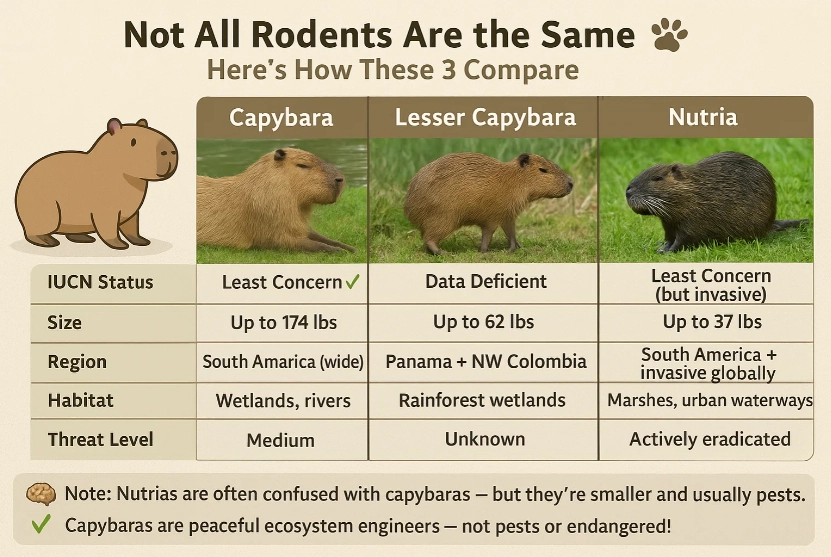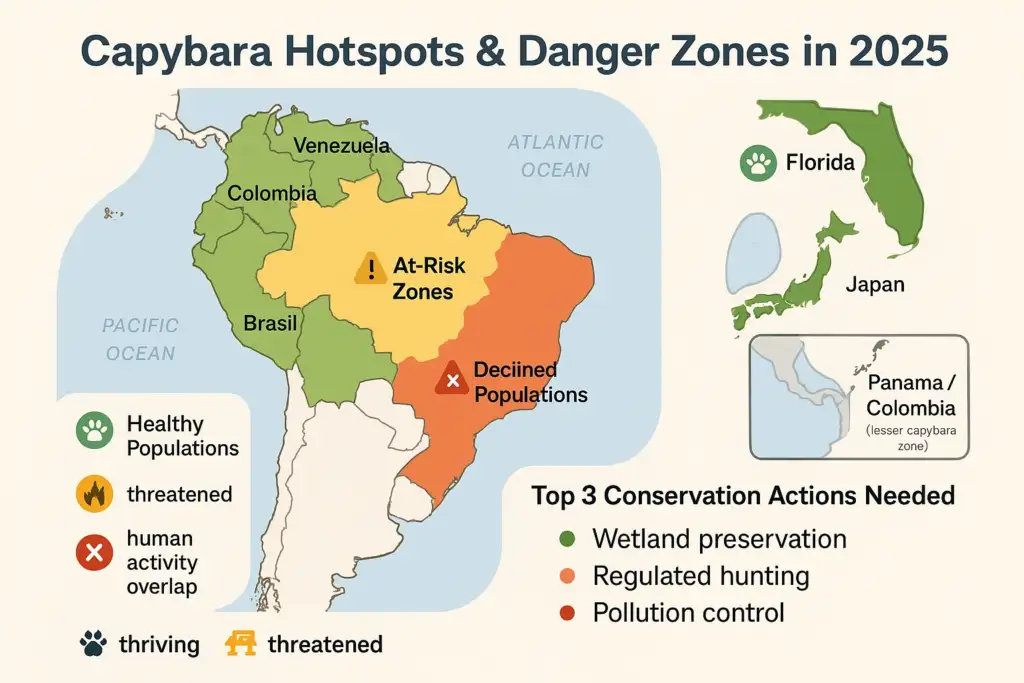Can Capybaras Be Potty Trained? Honest Vet Advice, Real Owner Reviews & Step-by-Step Training Guide.
July 22, 2025How Fast Can a Capybara Run? (Speed, Survival, and Surprising Comparisons)
July 23, 2025Capybaras aren’t endangered, but their population faces threats from habitat loss, poaching, and pollution. Learn their 2025 Red List status, protections, and how many are left in the wild.
Table of Contents
Are Capybaras Endangered?
No, capybaras are not endangered. As of 2025, they are listed as “Least Concern” by the IUCN Red List, meaning their population is stable across most of South America. However, regional threats like habitat destruction, poaching, and climate change still impact local populations.
Here’s the deal — while those adorable giant rodents with their chill vibes aren’t about to disappear tomorrow, they’re dealing with some serious challenges that could change their future. I’ve spent weeks researching these fascinating creatures, and what I found might surprise you.
Let’s break it down, shall we?
How Many Capybaras Are Left in the World?
Wondering exactly how many capybaras are kicking around planet Earth? That’s actually a tricky question — and the answer is a bit frustrating.
The truth? Nobody knows the exact number of capybaras left in the wild. Unlike endangered species that get precise counts, capybaras haven’t had a comprehensive population census. But here’s what we do know:
Population densities range from 10 to 195 individuals per square kilometer, depending on habitat quality
- Taronga Conservation Society estimates more than 3.5 million capybaras across nine countries
- Taronga Conservation Society estimates more than 3.5 million capybaras across nine countries
- Their distribution remains large and continuous throughout much of South America
The good news? Capybaras breed like, well… rodents. A healthy female can produce 1-2 litters annually, with 4-5 babies each time. This reproductive rate helps them maintain stable populations even with some hunting pressure.
That said, don’t get too comfortable with those numbers. Here’s why…
Are All Capybara Species Safe? (Lesser Capybara Confusion)
This might blow your mind — but when people talk about capybaras, they’re usually referring to just one species: the greater capybara (Hydrochoerus hydrochaeris). But there’s another one you need to know about.

The lesser capybara (Hydrochoerus isthmius) is the forgotten cousin in this story. And guess what? Its conservation status is listed as “Data Deficient” by IUCN — scientific-speak for “we honestly don’t know if they’re in trouble because we haven’t studied them enough.”
This creates massive confusion on social media platforms like Reddit and TikTok, where people often mix up the two species. Here’s how to tell them apart:
| Species | Status | Population Trend | Size | Range |
| Lesser Capybara | Data Deficient | Unknown | Up to 100 lbs | Panama to Venezuela |
| Greater Capybara | Least Concern | Stable | Up to 150 lbs | Most of South America |
The lesser capybara was only recognized as its own species in 1991 — before that, scientists thought it was just a smaller version of the regular capybara. So when someone asks, “Are capybaras endangered?” The answer depends on which species we’re discussing.
Not-so-fun fact: this confusion matters because conservation dollars typically flow to species with clear “endangered” labels, leaving the lesser capybara in a funding limbo.
Where Do Capybaras Live? Global Distribution Overview
Capybaras aren’t exactly globe-trotters, but they do cover a decent chunk of South American territory. These semi-aquatic rodents are found throughout:
- Brazil (particularly the Pantanal and Amazon regions)
- Venezuela (throughout the llanos wetlands)
- Colombia
- Peru
- Ecuador
- Paraguay
- Uruguay
- Argentina (up to about 38°S latitude)
The one South American country conspicuously missing? Chile. Their cold mountainous terrain just doesn’t provide the warm, wetland habitat capybaras need to thrive.

Love You 😉
But wait — there’s more! Capybaras are surprisingly adaptable and have been spotted in some unexpected places:
- Urban areas: They’ve famously “invaded” the upscale Nordelta neighborhood near Buenos Aires, Argentina
- City parks: Parque Barigui in Curitiba, Brazil has a thriving urban capybara population
- Golf courses: Several Brazilian and Argentine courses report regular capybara visitors
- Florida: Small feral populations have established themselves in certain regions
You might be wondering: “How do they end up in Florida?” Good question! Some were released by exotic pet owners who couldn’t handle their care requirements, while others escaped from private collections. Yeah, not great for the ecosystem — or the capybaras.
What Are the Biggest Threats to Capybaras?
Capybaras might not be endangered, but they’re certainly not living worry-free lives. Here’s what’s keeping these giant rodents up at night (besides their natural nocturnal habits):
1. Wetland Destruction & Habitat Loss
This is the big one, folks. Capybaras are *wetland specialists* — they need water bodies for:
- Escaping predators (they can hold their breath underwater for up to 5 minutes!)
- Regulating their body temperature
- Finding aquatic plants to eat
- Social interactions
When developers drain wetlands for agriculture or urban development, capybaras lose everything they need to survive. According to research from southeastern Brazil, capybara populations decline by 70-90% in regions where wetlands have been severely degraded .
What’s worse is many South American countries have weak wetland protection laws, meaning these critical habitats continue disappearing at alarming rates.
2. Poaching & Hunting
Sounds like something from a century ago, right? Unfortunately, it’s still a major problem in 2025.
Capybaras are hunted for:
- Meat: In many rural communities, capybara meat (sometimes called “water pig”) is a protein source. During Lent in some Catholic regions, capybaras are even classified as “fish” to allow consumption during meat-restricted periods!
- Hide: Capybara leather is used for gloves, shoes, and designer bags
- Oil: Some traditional medicinal uses involve capybara oil
While hunting is regulated in countries like Venezuela (where only 20% of the population can be legally harvested annually), illegal poaching continues to be a significant threat. Brazilian conservation law prohibits hunting capybaras, but enforcement in remote areas remains challenging.
3. Climate Change & Droughts
You didn’t think capybaras would escape climate change, did you? These semi-aquatic creatures are particularly vulnerable to changing weather patterns.
Increasing drought frequency in regions like the Pantanal wetlands directly impacts capybaras by:
- Reducing available water bodies
- Decreasing food availability
- Forcing them into smaller territories (increasing disease transmission)
- Driving them toward human settlements (creating conflict)
In 2020, catastrophic fires in the Pantanal destroyed crucial capybara habitat. As one researcher told me, “When wetlands dry up, capybaras have nowhere to go but into human spaces.”
And that leads us to…
Human Conflict or Coexistence?
So what happens when these 150-pound rodents and humans try to share space? It’s… complicated.
The Argentina Uprising
Let me tell you about what’s probably the most famous human-capybara conflict story. In 2021, hundreds of capybaras “invaded” Nordelta — an exclusive gated community near Buenos Aires built on former wetlands. The story went viral, with some dubbing it the “Capybara Revolution.”
These furry invaders chomped through gardens, caused traffic accidents, and pooped all over manicured lawns. But here’s where it gets interesting: rather than immediately removing them, many residents advocated for coexistence. They reduced lawn mowing to provide more natural grazing areas and created dedicated capybara zones within the community .
It’s not a perfect solution — there are still conflicts — but it represents a shift in how we might approach wildlife in urban spaces.
Farming vs. Foraging
In agricultural areas, the story is less heartwarming. Capybaras can damage crops like:
- Sugarcane
- Rice
- Corn
- Various fruits
This leads to retaliatory killings by farmers trying to protect their livelihoods. However, some innovative ranchers in Brazil and Venezuela have discovered that cattle and capybaras can actually coexist relatively peacefully, with capybaras grazing on plants the cattle don’t prefer.
Disease Transmission Concerns
Here’s something many people don’t realize: capybaras can serve as hosts for ticks that transmit Brazilian Spotted Fever to humans. In urban areas where capybaras concentrate in small spaces, this creates legitimate public health concerns.
Research shows that “the aggregation of capybaras in very small home ranges might imply greater risk of diseases spread by tick infestations” .
This isn’t the capybaras’ fault — they’re just trying to survive — but it adds another layer of complexity to human-capybara interactions.
Legal Protection: Are Capybaras Protected by Law?
The legal protection for capybaras varies dramatically by country — which makes conservation efforts frustratingly inconsistent. Here’s the breakdown:
Brazil: Federal Protection (With Complications)
In Brazil, capybaras are protected under federal law (Federal Law No. 5.197 from 1967), making hunting them generally illegal. However — and this is a big however — local authorities in some regions are considering allowing harvesting to reduce densities in areas where capybaras conflict with agriculture or spread disease .
According to Brazilian environmental lawyer Felipe Neves Linhares, “Capybaras are protected under Brazilian environmental law… but the city is on solid legal footing with its current measures” for managing urban populations .
Venezuela: Regulated Seasonal Hunting
Venezuela takes a different approach. Since 1953, they’ve regulated capybara hunting, and in 1968, they developed a management plan based on extensive biological studies. Their system allows approximately 20% of the capybara population to be harvested annually with proper permits.
Sounds reasonable, right? The problem is enforcement. Illegal poaching continues to be an issue in remote areas where law enforcement is sparse.
Argentina: Provincial Variations
Argentina’s federal system means each province sets its own wildlife regulations. In Entre Ríos province, hunting capybaras is totally prohibited, while other provinces allow regulated hunting .
Again, enforcement varies widely, especially in remote areas.
Colombia: Full Protection (In Theory)
Colombia prohibited capybara hunting in 1980, but poaching remains common, particularly for the traditional Easter dish of dried capybara meat.
Bottom line? Laws exist, but enforcement is inconsistent at best. Without better on-the-ground protection, these legal shields may not be enough to protect capybaras from future population declines.
Do Zoos and Captive Programs Help or Hurt?
This is where things get a bit contentious. Zoos and breeding programs: capybara saviors or part of the problem?
The Education Argument
Supporters of zoological gardens point to the educational value of having capybaras on display. And they’ve got a point — it’s hard to care about an animal you’ve never seen or heard of.
The San Diego Zoo, for example, includes information about capybara conservation with their exhibits, raising awareness about wetland preservation. And let’s be honest, those viral videos of capybaras lounging with other animals have done more for their public image than any textbook could.
Breeding Programs: Mixed Results
Some zoos participate in capybara breeding programs. For example, Hunter Valley Zoo in Australia established the first successful capybara breeding program in the country in 2018 .
More recently, the Palm Beach Zoo announced participation in a Species Survival Plan for capybaras .
But here’s the thing — since capybaras aren’t endangered, these programs aren’t about releasing animals back into the wild. They’re focused on maintaining captive populations for education and exhibition purposes.
Ethical Considerations
Critics argue that capybaras — semi-aquatic, highly social animals that need lots of space — suffer in captivity. Their natural behaviors include:
- Forming groups of 10-20 individuals
- Swimming daily in large water bodies
- Grazing for hours each day across extensive territories
- Creating complex social hierarchies
Even the best zoo habitats struggle to provide enough space and social complexity for these requirements. The judgment is mixed, but it’s worth considering whether the educational benefit outweighs potential welfare costs.
Is It Ethical to Keep Capybaras as Pets?
I know, I know — those TikTok videos of pet capybaras are adorable. But before you start browsing exotic pet websites, let me break this down for you.
Legal Status by Region
First, can you legally own a capybara? It depends entirely on where you live:
- Legal in some US states: Texas, Florida, Pennsylvania, Arkansas, Arizona, Indiana, Nevada, Washington, North Carolina, and Tennessee typically allow capybaras with proper permits
- Illegal in: California, Georgia, and many other states
- Illegal in Brazil: Despite being their native country, it’s illegal to own capybaras as pets in Brazil
- UK: Legal with a special license
But legal doesn’t always mean ethical. Here’s why most animal welfare experts strongly discourage keeping capybaras as pets:
The Space Requirements Are Enormous
You thought a Great Dane needed room? Ha! Capybaras need:
- A large outdoor enclosure (minimum 600 square feet per animal)
- A swimming pool or pond (minimum 9ft x 16ft with a depth of 4ft)
- Protection from extreme temperatures
- Extensive grazing areas

Unless you’ve got a small farm or ranch, providing adequate space is nearly impossible.
The Social Needs Are Complex
Capybaras are intensely social creatures. Keeping just one is considered cruel by most experts. You’d need at least a pair, preferably more — meaning you’re signing up for multiple 100+ pound rodents with all their space requirements, not just one.
The Financial Reality Check
If you’re still thinking about it, consider the costs:
- Purchase price: $1,000-$3,000 per capybara
- Housing setup: $500-$2,000 for proper enclosure and pool
- Monthly food: $40-$100 for fresh produce and hay
- Veterinary care: Good luck finding an exotic vet who specializes in capybaras!
Plus, their teeth grow continuously (just like other rodents), which can lead to dental problems if they don’t have proper materials to gnaw on .
Look, I get the appeal. They’re ridiculously cute. But the reality is that very few people can provide the environment capybaras need to thrive. And when they can’t, capybaras often end up abandoned or surrendered — contributing to the feral populations now appearing in places like Florida.
What Are Conservationists Doing to Protect Capybaras?
Despite not being endangered (yet), there are still dedicated folks working to ensure capybaras don’t slide toward that status in the future. Here’s what’s happening on the conservation front:
Wetland Restoration Efforts
Since capybaras are wetland specialists, preserving and restoring these ecosystems directly benefits their populations. Some notable projects include:
- Iberá Wetlands Project in Argentina: This massive conservation initiative is restoring wetlands and reintroducing native species that had disappeared from the region
- Pantanal Conservation Areas: Protected zones that secure vital capybara habitat
- Private Reserves in Brazil: Some landowners maintain protected wetlands that serve as capybara sanctuaries
These initiatives don’t just help capybaras — they benefit countless other species that share wetland habitats, from caimans to marsh deer.
Management in Urban Areas
Some cities are taking innovative approaches to managing urban capybara populations:
- Research Instead of Removal: In Brazil, some cities are investing in research to understand how to co-exist with capybaras rather than simply removing them
- Dedicated Capybara Zones: Creating designated areas in urban parks where capybaras can live with minimal human conflict
- Education Programs: Teaching residents how to safely coexist with capybaras
Updated IUCN Assessments (Needed)
Here’s something that might surprise you — the last official IUCN assessment of capybaras was conducted in 2016. That’s nearly a decade old at this point! Many conservationists are pushing for updated population studies and a fresh assessment, particularly for the data-deficient lesser capybara.
With climate change accelerating and habitat pressures increasing, having current data is crucial for effective conservation planning.
How You Can Help Capybaras?
You made it this far, which means you probably care about these wonderful creatures. So what can you actually do to help them? Plenty, as it turns out!
1. Support Wetland Conservation Organizations
Organizations working to protect and restore wetlands in South America directly benefit capybaras. Consider supporting:
- World Wildlife Fund’s Pantanal conservation efforts
- The Conservation Land Trust’s work in the Iberá Wetlands
- Local South American conservation organizations focused on wetland protection
Even small donations can help protect critical habitat.
2. Say No to the Exotic Pet Trade
I know those TikTok videos are adorable, but the best thing you can do for capybaras is *not* create demand for the exotic pet trade. Instead:
- Share educational content about why they don’t make good pets
- Report illegal capybara sales when you see them online
- Educate others about the space and social requirements capybaras need

3. Visit Ethical Wildlife Experiences
If you want to see capybaras in person (and who wouldn’t?), choose ethical options:
- Ecotourism operations in Brazil, Argentina, or Venezuela that observe wild capybaras
- Zoos with large, natural habitats and strong conservation messaging
- Wildlife sanctuaries that rescue rather than breed capybaras
Your tourism dollars can incentivize habitat protection when spent responsibly.
4. Spread Awareness (The Right Way)
Social media can be a powerful conservation tool when used correctly:
- Share accurate information about capybara conservation status
- Highlight the threats they face from habitat loss and climate change
- Support campaigns for wetland protection in South America
- Correct misinformation when you see it (especially confusion between the two capybara species!)
Fun Capybara Facts Google Users Love
Let’s end on a lighter note with some capybara facts that might just blow your mind:
- Underwater masters: Capybaras can hold their breath for up to 5 minutes underwater and often sleep with just their noses above the surface
- Vocal virtuosos: They communicate using an impressive range of sounds including purrs when content, barks when alarmed, whistles to keep track of babies, and even clicks and chirps for general chatting
- Communal nurseries: Female capybaras will nurse babies that aren’t their own, creating a communal childcare system within their herds
- Ever-growing chompers: Like all rodents, their teeth grow continuously throughout their lives, which is why they need to chew constantly on tough vegetation
- Mega-herd formation: During dry seasons, typically territorial capybara groups will form temporary “mega-herds” of 100+ individuals to share limited water resources
- Poop recycling: Capybaras practice coprophagy (eating their own poop) to extract maximum nutrition from their food and get beneficial gut bacteria
The Bottom Line: Not Endangered, But Not Safe Either
So are capybaras endangered in 2025? No, not yet. But their story is more complex than a simple conservation status can convey.
While their overall population remains stable enough to keep them off endangered lists, local threats are intensifying. Without dedicated conservation efforts, strengthened legal protections, and better habitat management, these charismatic rodents could face a very different future.
The good news is that capybaras have proven remarkably adaptable, even making homes in urban environments when necessary. With proper management and protection of their wetland habitats, these social, semi-aquatic creatures can continue to thrive for generations to come.
And honestly? The world would be a much less interesting place without them.
